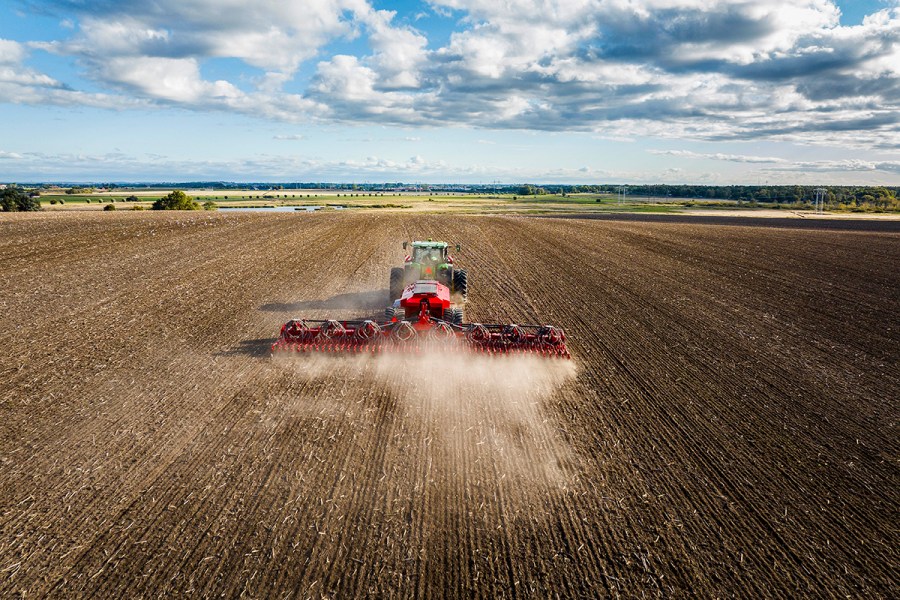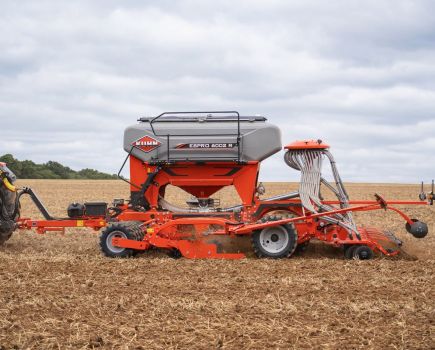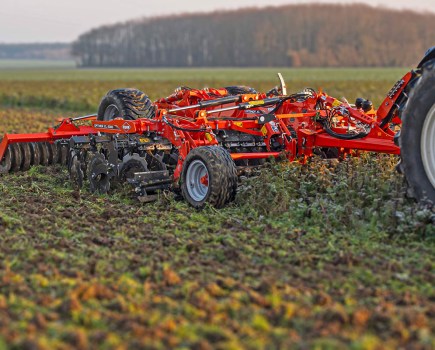One way to overcome the challenge of shortening weather windows is to build an armoury ready to tackle any opportunity. CPM speaks to one farmer whose tactical machinery purchases have allowed him to do just this, all while reducing inputs and maintaining output.
“It’s taking us years to bring structure back to the soil.” – MICHAEL PORTER
By Melanie Jenkins
A shift in approach at Porters Somerton Farms near Lincoln has seen Michael Porter, alongside his brother James and father Graham, prioritise soil health which they’ve propagated through investment in machinery.
Having previously run a high- intensity, high-horsepower operation, the farm has shifted its approach to focus on soil health and organic matter during the past two years. “We used to run deeper rippers at 36cm but when driving the sprayer across the fields we found ruts and realised the deep inversion was creating more damage,” explains Michael.
Soil management now involves a lot less cultivation to allow the clay soils to work themselves. “But it’s taking us years to bring structure back to the soil. The Väderstad TopDown we’ve had on farm works really well with this approach despite the harsher weather patterns we’ve experienced.”
And while the TopDown has been a faithful on the farm for a decade, Michael took the decision to introduce a new cultivator and change his drill to open up his working windows and reduce input costs. “During the spring of 2024, a demo of Väderstad’s Inspire was brought to the farm and I fell in love with it right away, to the point that the demo never left the farm.
“Then in the summer Väderstad’s Ed Hutchinson supplied a demo of the Carrier XL 925 with CrossCutter Discs which produced a nice seedbed in front of the drill, with both working really well in partnership.”
Although Michael will keep his TopDown to use on around a quarter of his primary cultivations and still has a Sumo Quatro on farm, he’s been impressed with the build quality and durability of the Carrier XL 925. “Its output sits at 16ha per hour meaning it stays ahead of the drill nicely.”
The Inspire is a 12m disc drill which works best in cultivated land, he explains. “It’s the first 12m drill we’ve had on the farm which now runs on the same wheelings as the sprayer, helping to protect our soils more. Compaction is an issue that’s very much on my mind and ideally, I don’t want to compact soils at all because it’s so costly.”
In addition to prioritising soil health, the change in approach has also tied in with efforts to lower input costs without reducing the farm’s output. “With the cost of labour having increased as much as inputs, managing this has also been important to us. When my brother and I were younger, we were affordable labour, but now, if we were to subsoil, run the combine, cart corn, undertake primary cultivations, spread muck, and more besides, the labour costs just don’t add up.
“As it is, the farm still supports my father, brother, and me, plus we have three permanent operators and seasonal workers. So, it’s really been a good time to look at different methods in how we operate without jeopardising our yields.”
Michael has noticed that the different approach has opened up the farm’s drilling window by about two weeks. “We’ve been able to drill into October confidently whereas with the previous drill, if the ground became wet and sticky, we’d have to sit and wait, hoping the conditions would dry up. But with the weather behaving as it has during the past few years we just can’t take this risk any longer.”
YIELD RESTRICTIONS
The farm previously ran an 8m Väderstad Rapid – a drill which has packing wheels at the rear. “This is a cultivating drill and during the wet autumn of 2023 we found the headlands were heavily compacted and there was poor establishment, resulting in some of our winter wheat only yielding 3t/ha on our heavy clay headlands which just wasn’t good enough.
“With the new setup, we’re now able to achieve a good chit of blackgrass, spray this off, and go in with the Inspire. And because it isn’t a cultivating drill, we aren’t disturbing the soil as much as we were in the past so the headlands are looking great and we’re really happy with the results.”
Michael adds that because it’s working on 12.5cm row spacings, it allows a thick canopy to establish which competes with grassweeds. “Compared with the autumn of 2023, establishment has been great which proved it was the right call to look for a drill like the Inspire. It went into tricky conditions but it’s proved itself, allowing us to drill later than we ever have without feeling any repercussions or doubts, and it’s been immediately obvious that there’s no serious compaction from using it.
“On top of this, our output is now around 14ha per hour, which means we can confidently cover 100ha per day which is better than what we’ve achieved in the past.”
When deciding which drill to purchase, he’d also looked at a 12m Horsch Avatar, but it was the coulter spacings on the Inspire that really sealed the deal. “I want to look out at the fields and see a thick canopy with a high green area index. The Inspire’s 1.5m sections mean the seed saving is brilliant whereas on the Avatar these are two 6m, meaning we might have double drilled or run over the crop.”
During the coming season, Michael aims to focus even more on soil compaction. “We’ve changed our machinery a lot during this past year but the aim has been to bring more technology to the farm. Previously, most of the pulling work was done by a Claas Xerion but we’ve replaced this with a John Deere 8R with a central tyre inflation system (CTIS) and a tracked 8RX, to see what advantages can be gained.
“I was happy to spend more on the CTIS to look after our soils in the autumn and to run higher horsepower tractors and lower the pressures. We’re planning to assess the level of compaction we’re leaving behind and at what depths because this’ll help us to dictate how deep we go in with the TopDown. Plus, changing the tractors means we’ve actually gone down 100hp, so we’re actually seeing a reduction in fuel use.
“When running the Xerion with the Rapid, it’d burn through 90 l/hr, but with the John Deeres and Inspire this is just 44 l/hr, or 3.2 l/ha. However, the Xerion was 12 years old which will have had an impact,” he adds.
DATA INSIGHTS
Using John Deere’s Operations Center, Michael has been able to produce prescription drilling plans for the drill operators across the farm’s medium soils, sandy loams, and heavy clays. “The operators used to have to do this themselves but with the ability to send the prescription maps via the Cloud, I can set the kg/ha of seed and the system determines whether to apply more or less, depending on the soil type.
“It’s proven to be really interesting for us to work with the soil maps produced from the data. It only takes five minutes to create a job plan for the Inspire or Carrier XL 925 and both work perfectly in sync as a result.”
He also plans to look closer at residual nitrogen and pay even more attention to organic matter content. “We’ve assessed the organic matter for years but only started to inspect residual N in 2023. We use chicken muck on the farm which is tested twice per year, applying it in spring and autumn. It’s like rocket fuel especially when used for second wheats and oilseed rape.
“Using it is all part of lowering our input costs and ties into my overall aim of establishing a good working system where we aren’t sacrificing yields and are creating a nice profit for the farm.”
This article was taken from the latest issue of CPM.
For more articles like this, subscribe here.
Sign up for Crop Production Magazine’s FREE e-newsletter here.




